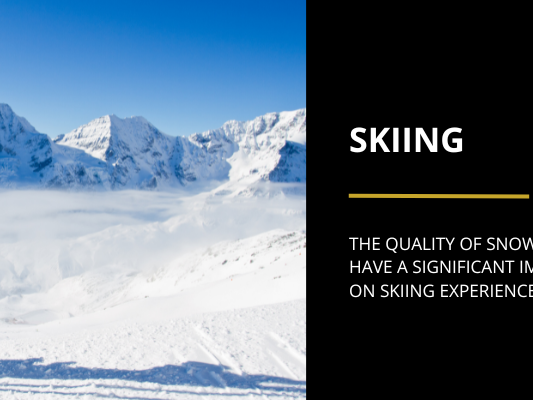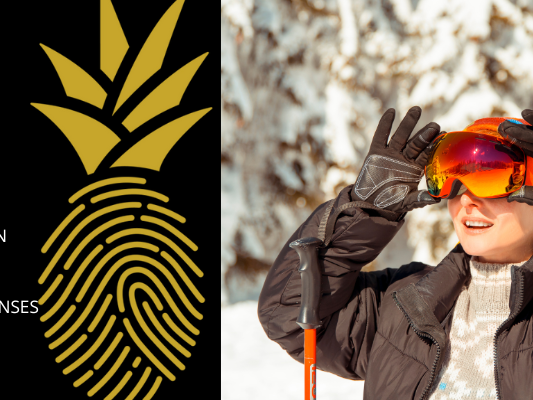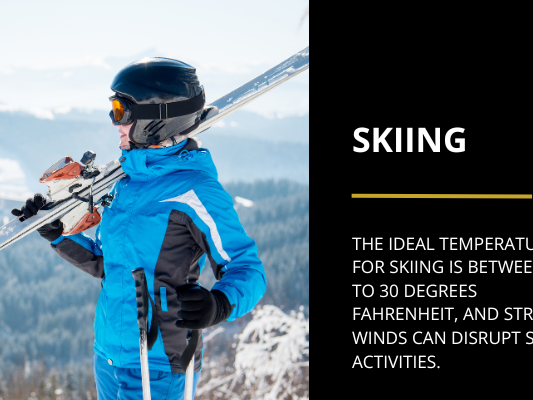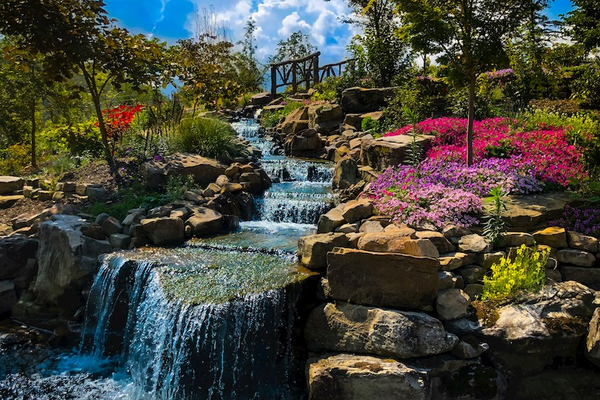Skiing is a popular winter sport that many people enjoy. While skiing is fun, it can also be dangerous if proper precautions are not taken. One of the most important factors to consider when skiing is the weather. Understanding the weather conditions can help skiers choose the best time and location to ski, as well as the appropriate equipment to use.
When it comes to skiing, the weather can greatly impact the overall experience. Different weather conditions can affect the quality of the snow, the visibility on the slopes, and the safety of the skiers. Understanding the weather conditions can help skiers choose the best time to hit the slopes and ensure they have a safe and enjoyable experience.
Blog Summary
- Understanding the weather conditions is important for choosing the best time and location to ski, as well as the appropriate equipment to use.
- Different weather conditions can greatly impact the quality of the snow, the visibility on the slopes, and the safety of the skiers.
- By considering the weather conditions, skiers can ensure they have a safe and enjoyable experience on the slopes.
Understanding Ski Weather Conditions
Skiing is a weather-dependent activity, and understanding ski weather conditions is essential for an enjoyable and safe experience on the slopes. The weather can affect the snow conditions, the visibility, and the temperature, all of which can impact the overall ski experience.
Weather forecasts are an essential tool for skiers to plan their ski trips. It is recommended to check weather forecasts before heading to the mountain. Skiers should pay attention to the temperature, precipitation, wind, and humidity levels.
The ideal temperature range for skiing is between 20°F and 32°F (-7°C and 0°C). In this range, the snow is in perfect condition, making it easier to glide over the surface. Additionally, the muscles are less likely to tighten up, allowing skiers to move more freely and maintain proper form.
Precipitation can also affect the ski conditions. Fresh powder is ideal for skiing, but too much snow can make it difficult to navigate the slopes. Skiers should also be aware of the type of snow, as different snow types can affect the ski experience. For example, powder snow is light and fluffy, making it ideal for deep powder skiing, while wet snow is heavy and can slow down skiers.
Wind can also impact the ski experience. Strong winds can cause lift closures and make it difficult to ski. Skiers should be aware of the wind chill factor, as it can make the temperature feel much colder than it actually is.
In addition to weather forecasts, skiers can also check the snow reports for the mountain they plan to ski. Snow reports provide information on the snow conditions, such as the base depth, the new snowfall, and the open lifts and trails.
Understanding ski weather conditions is crucial for a successful ski trip. Skiers should pay attention to weather forecasts, precipitation, wind, and snow reports to plan their ski trip accordingly.
Best Months for Skiing
When it comes to skiing, the weather can make or break a trip. The best time to ski varies depending on a variety of factors, including snow conditions, crowds, and weather. Here are some of the best months for skiing:
December
December is the beginning of ski season for many resorts and can be a great time to hit the slopes. While snow conditions may not be as good as later in the season, the holiday season can bring a festive atmosphere to the mountains. However, Christmas and New Year's can be some of the busiest times of the year, so be prepared for crowds.
January
January is typically a great time to ski. The holiday crowds have dispersed, and many resorts have had time to build up a good base of snow. This can be a particularly good time to ski in the western United States, where snow conditions tend to be better than in the east.
February
February is often considered the best month for skiing. The snow is typically at its deepest, and the weather tends to be more consistent. This can be a great time to plan a ski trip, but be prepared for crowds during President's Day weekend.
March
March can be a great time to ski, particularly in areas that receive a lot of snow. The days are longer, and the weather can be more mild, making for a comfortable day on the slopes. However, this can also be a time when snow conditions start to deteriorate, so it's important to keep an eye on the weather forecast.
April
While April marks the end of the ski season for many resorts, it can be a great time to ski in areas that receive a lot of spring snow. The weather is typically warmer, and the days are longer. This can be a great time to plan a trip if you're looking for a more relaxed atmosphere and don't mind skiing on slushy snow.
Overall, the best time to ski depends on your preferences and priorities. Whether you're looking for fresh powder or a festive atmosphere, there's a time of year that's right for you.
Ideal Skiing Locations
When it comes to finding the best weather for skiing, location is key. Some of the best skiing locations in North America include Colorado and Utah, which are known for their world-class ski resorts and varied terrain. These states have a wide range of slopes, from beginner to expert, and offer a variety of off-piste skiing opportunities.
In Colorado, ski resorts such as Vail, Breckenridge, and Keystone offer some of the best skiing conditions in the country. With an average annual snowfall of over 300 inches, these resorts have plenty of fresh powder for skiers to enjoy. Additionally, Colorado's high altitude and dry climate make for excellent skiing conditions, with temperatures ranging between 20°F and 32°F (-7°C and 0°C) being the optimal range for skiing.
Utah is another popular skiing destination, with ski resorts such as Park City and Deer Valley offering over 9,000 acres of skiable terrain. The state's dry climate and high altitude make for excellent powder skiing conditions, with temperatures ranging between -6°C and -1°C being ideal. Additionally, Utah's backcountry skiing opportunities are some of the best in the country, with the Wasatch Mountains offering some of the most challenging and rewarding off-piste skiing experiences.
While ski resorts are a popular option for skiing, backcountry skiing is also a great way to enjoy the sport. Backcountry skiing involves skiing in unmarked and unpatrolled areas, and requires a higher level of skill and experience. However, it also offers some of the best skiing conditions, with fresh powder and untouched terrain.
Overall, when it comes to finding the best weather for skiing, location is key. Ski resorts in Colorado and Utah offer some of the best skiing conditions in North America, with a variety of terrain and off-piste skiing opportunities. Additionally, backcountry skiing provides some of the best skiing experiences, with fresh powder and untouched terrain for skiers to enjoy.
Impact of Snow Conditions on Skiing
The quality of snow can have a significant impact on skiing experience. Fresh snow, also known as powder, is generally preferred by skiers as it provides better traction and control. The best skiing conditions are often found in temperatures between -6 and -1 degrees Celsius, where the snow is not so cold that skiing becomes uncomfortable, and yet not warm enough that the snow begins to melt.
Snow reports and ski conditions are crucial for skiers to plan their trip and make informed decisions about where to ski. Snow reports provide information about the current snow conditions, including the depth and quality of the snow. Ski conditions, on the other hand, provide information about the overall skiing experience, including the number of open trails, lifts, and terrain parks.
Fresh powder
Ideal for skiing as it provides a soft landing and allows for easy maneuverability. Skiers can make sharp turns and carve through the snow with ease. However, skiing in deep powder can be challenging for beginners as it requires more effort to maintain balance and control.
Snowfall
Can also affect skiing conditions. Heavy snowfall can create a layer of fresh powder on top of the existing snow, making it difficult to navigate. Skiers may need to adjust their technique to maintain balance and control.
Snow forecast
Another critical factor for skiers to consider when planning their trip. It provides information about the expected weather conditions, including snowfall and temperature. Skiers can use this information to plan their trip and ensure they have the best skiing experience possible.
Snow conditions have a significant impact on skiing experience. Fresh powder is ideal for skiing, and snow reports, ski conditions, snowfall, and snow forecast are all crucial factors for skiers to consider when planning their trip.
Understanding the Impact of Visibility on Skiing
Visibility is a crucial factor when it comes to skiing. It is essential to have good visibility to ensure that skiers can see the terrain and any obstacles in their path. Poor visibility can lead to accidents and injuries.
The amount of visible light that can pass through the lens of a ski goggle is known as Visible Light Transmission (VLT). The VLT rating determines how much light can pass through the lens and reach the skier's eyes. A low VLT rating means that less light can pass through the lens, making it suitable for sunny days. On the other hand, a high VLT rating means that more light can pass through the lens, making it ideal for cloudy or overcast days.
Flat light
Flat light is a term used to describe the lighting conditions when there is no contrast between the snow and the sky. Flat light can make it difficult for skiers to differentiate between the terrain and any obstacles. It is especially dangerous for beginner skiers who may have difficulty navigating through the terrain.
Glare
Glare is another issue that skiers face when skiing in bright conditions. Glare occurs when the sun reflects off the snow, making it difficult for skiers to see. To combat glare, skiers can use goggles with lenses that have a filter. Yellow, amber, and green lenses are ideal for cloudy or overcast days, while gray and blue lenses are suitable for sunny or bluebird days.
Having good visibility is essential for skiing. Skiers should choose goggles with lenses that have a suitable VLT rating for the lighting conditions. They should also consider using lenses that have a filter to combat glare. By taking these precautions, skiers can enjoy a safe and enjoyable skiing experience.
Protective Eyewear for Different Weather Conditions
When it comes to skiing, having the right equipment can make all the difference in your performance and enjoyment on the slopes. One of the most important pieces of equipment is your ski goggles, which protect your eyes from the sun, wind, and snow.
For sunny days, it's best to choose ski goggles with lenses that have a lower VLT (visible light transmission) rating, such as 10-20%. These lenses are darker and provide better protection from the sun's glare. Mirrored lenses are also a good option as they reflect the sunlight away from your eyes.
On the other hand, for cloudy or overcast days, it's best to choose ski goggles with lenses that have a higher VLT rating, such as 50-80%. These lenses are lighter and allow more light to pass through, providing better visibility in low-light conditions.
Interchangeable lenses
For those who ski in different weather conditions, interchangeable lenses are a great option. These lenses can be easily swapped out depending on the weather, allowing you to have the best visibility and protection no matter the conditions.
Snowboard goggles
Snowboard goggles are another option to consider, as they often have larger lenses that provide a wider field of vision. They also tend to be more durable and have better anti-fogging properties.
Overall, having the right ski goggles with the appropriate lenses can greatly improve your skiing experience and keep you safe on the mountain.
How Weather Affects Skiing Safety
Weather plays a crucial role in skiing safety. Skiers need to be aware of the weather conditions before hitting the slopes. Extreme weather conditions can be dangerous and can lead to accidents. Here are some ways in which weather can affect skiing safety:
Wind
Strong winds can make skiing difficult and dangerous. Wind can cause snow drifts and create a wind chill that can make the temperature feel much colder than it actually is. It can also cause snow to blow across the slopes, reducing visibility. Skiers need to be aware of the wind speed and direction before skiing.
Snow
Snow is the main ingredient for skiing, but too much snow can be dangerous. Heavy snowfall can create unstable snowpacks and increase the risk of avalanches. Skiers should always check the weather forecast and avalanche warnings before skiing.
Temperature
Temperature can affect the quality of the snow and the skier's safety. Warm temperatures can cause the snow to become slushy and difficult to ski on. Cold temperatures can cause the snow to become hard and icy, making it difficult to control skis. Skiers should dress appropriately for the temperature and weather conditions.
Visibility
Visibility is crucial for skiing safety. Low visibility can make it difficult for skiers to see obstacles and other skiers. Fog, snow, and darkness can all reduce visibility. Skiers should use caution and slow down when visibility is poor.
Other Factors
Other weather-related factors that can affect skiing safety include storms, desert climates, humidity, air pressure, and more. Skiers should always be aware of the weather conditions and how they might affect their safety on the slopes.
In summary, weather can have a significant impact on skiing safety. Skiers should always check the weather forecast and avalanche warnings before skiing. They should also dress appropriately for the temperature and weather conditions, use caution when visibility is poor, and be aware of other weather-related factors that can affect their safety.
Cost Implications of Skiing in Different Weather Conditions
Skiing can be an expensive sport, and the cost can vary depending on the weather conditions. In general, skiing in colder weather conditions is more expensive due to the increased need for snowmaking. As temperatures rise, snowmaking becomes more difficult, and resorts must use more energy to create artificial snow. This added cost is often passed on to the skiers in the form of higher lift ticket prices.
According to a report by researchers at Texas A&M University, the rising costs of climate change threaten to make skiing a less diverse and even more exclusive sport. As temperatures warm, ski and snowboard resorts are investing more in snowmaking and seeing their seasons shrink. Those costs roll down to customers in an already expensive sport, researchers say.
In addition to the cost of snowmaking, skiing in warmer weather conditions can also lead to higher costs due to the increased wear and tear on equipment. Skis and snowboards can become damaged more easily in slushy or wet conditions, leading to the need for more frequent repairs or replacements.
However, it's worth noting that skiing in colder weather conditions isn't always cheaper. Extremely cold temperatures can also lead to higher costs, as resorts may need to close certain lifts or runs due to safety concerns. Additionally, colder temperatures can lead to increased energy costs for resorts, as they must heat buildings and maintain equipment in order to keep them functioning properly.
Overall, the cost implications of skiing in different weather conditions can be complex and vary depending on a number of factors. Skiers should consider the weather conditions and associated costs when planning their trips to ensure they are able to enjoy the sport without breaking the bank.
How Weather Conditions Affect Ski Events
Weather conditions play a crucial role in determining the success of ski events. The ideal weather conditions for skiing are low temperatures and fresh snow. Warm weather, rain, or dry spells can cause a lack of snow, making it difficult for skiers to glide over the surface.
- Ski events are often scheduled months in advance.
- Weather conditions can be unpredictable.
- When temperatures are too high, snow can melt, making it difficult for skiers to move.
- This can result in canceled or postponed events.
In addition to temperature, wind speed and direction can also affect ski events. Wind can cause snow drifts and make it difficult for skiers to see. Wind direction can also affect the course layout, causing skiers to adjust their technique.
Snow quality is another factor that can affect ski events
The ideal snow for skiing is dry and powdery, which provides good traction and allows skiers to glide easily. Wet snow, on the other hand, can be heavy and slow, making it difficult for skiers to move.
Climate change is affecting ski events worldwide
Rising temperatures and changing weather patterns are causing a lack of snow, resulting in canceled or postponed events. Ski resorts are also investing in artificial snow-making technology to ensure that events can take place even when natural snow is scarce.
In summary, weather conditions play a crucial role in ski events. Low temperatures, fresh snow, and good snow quality are ideal for skiing. Warm weather, rain, and dry spells can cause a lack of snow, resulting in canceled or postponed events. Wind speed and direction can also affect ski events, as can climate change.
Impact of Elevation and Weather on Skiing
Elevation and weather conditions have a significant impact on skiing. Skiers need to be aware of these factors to choose the best time and location for their skiing trips. Here are some of the key ways in which elevation and weather affect skiing:
Elevation
Elevation plays a crucial role in skiing. As the altitude increases, the air pressure decreases, and the air becomes thinner. This can affect the skier's breathing, making it more difficult to breathe at higher altitudes. Skiers may experience altitude sickness, which can cause headaches, nausea, and fatigue.
Moreover, the snow quality varies with elevation. Higher elevations usually have colder temperatures, which result in drier snow. This type of snow is ideal for skiing as it provides better grip and control. In contrast, lower elevations have warmer temperatures, which lead to wetter snow. This type of snow is more challenging to ski on as it is slippery and offers less control.
Weather
Weather is another critical factor that affects skiing. The ideal temperature for skiing is between 20 to 30 degrees Fahrenheit (-6.7 to -1.1 degrees Celsius). At this temperature range, the snow is neither too hard nor too soft, providing the best skiing experience.
Wind is another weather condition that affects skiing. Strong winds can cause snowdrifts, which can make it difficult for skiers to navigate. Additionally, high winds can cause lifts to shut down, disrupting skiing activities.
Skiers need to consider elevation and weather conditions when planning their skiing trips. Higher elevations provide better snow quality, but also pose altitude-related challenges. The ideal temperature for skiing is between 20 to 30 degrees Fahrenheit, and strong winds can disrupt skiing activities.
Frequently Asked Questions
What are the ideal weather conditions for skiing?
The ideal weather conditions for skiing are cold temperatures, low humidity, and fresh snow. Skiers typically prefer temperatures between 20 to 30°F (-6.7 to -1.1°C), with low humidity to avoid wet and heavy snow. Fresh snow is also preferred as it provides better traction and control on the slopes.
How does temperature affect skiing conditions?
Temperature has a significant impact on skiing conditions. If the temperature is too warm, the snow can become slushy and difficult to ski on. If the temperature is too cold, the snow can become icy and hard to control. The ideal temperature range for skiing is between 20 to 30°F (-6.7 to -1.1°C).
What is the optimal amount of snow for skiing?
The optimal amount of snow for skiing depends on the type of skiing and the skier's skill level. For beginners, a depth of 4 to 6 inches (10 to 15 cm) is ideal, while intermediate and advanced skiers prefer a depth of 6 to 12 inches (15 to 30 cm). However, the quality of snow is more important than the depth, and fresh snow is always preferred.
Can skiing be enjoyable in warm weather?
Skiing can still be enjoyable in warm weather, but the conditions may not be ideal. Warm weather can cause the snow to become slushy and heavy, making it difficult to ski on. However, some skiers enjoy skiing in warmer weather because there are typically fewer crowds and more sunshine.
What are some tips for skiing in less than ideal conditions?
When skiing in less than ideal conditions, it is important to adjust your skiing technique. For example, if the snow is icy, use shorter turns and keep your weight over your skis. If the snow is slushy, use longer turns and keep your weight centered. Additionally, it is important to dress appropriately for the weather and wear sunscreen to protect your skin from the sun.
Why is fresh snow preferred for skiing?
Fresh snow is preferred for skiing because it provides better traction and control on the slopes. Additionally, fresh snow is less likely to be icy or slushy, making it easier and more enjoyable to ski on. Skiers also enjoy the feeling of skiing through fresh powder, which can be exhilarating and fun.

















